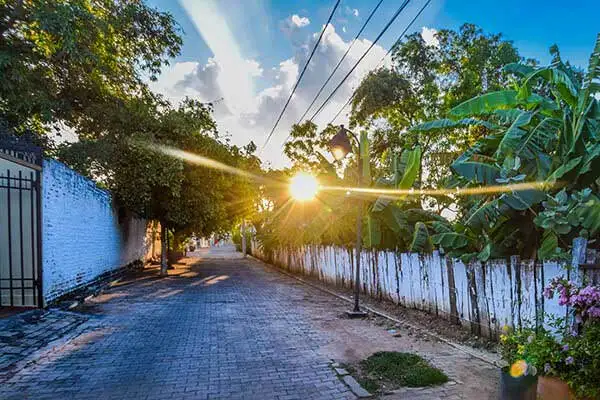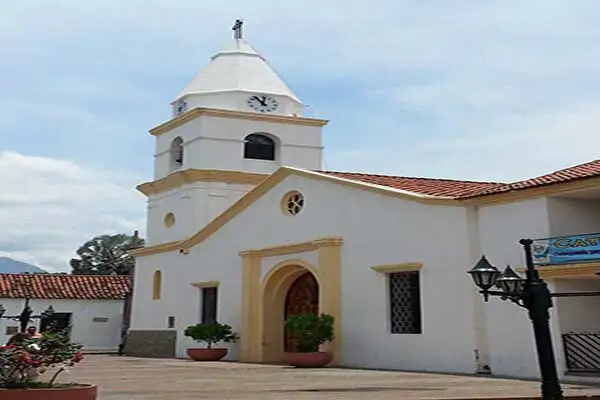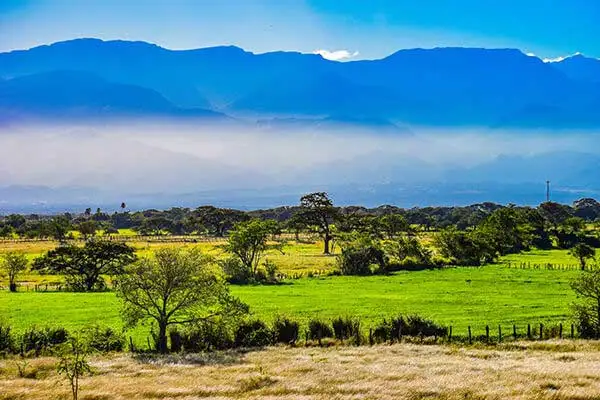By Michelle Thompson
The city of Valledupar was first named Valley of Upar, after the Indigenous leader cacique Upar of the Chimila people. For centuries, it has been a center for the importation and distribution of foods to the rest of Colombia, largely due to its proximity to seaside ports like Barranquilla and Cartagena—it is around an eight-hour bus ride away from these popular cities. The region has seen notable European and Middle Eastern migration since War World II, including French, German, Italian, Lebanese, Syrian, and Palestinian families.
The most significant aspect of Valledupar is that it is known as the birthplace of vallenato music. Vallenato is Colombia’s national music and is part of its collective identity. Played with the accordion, the caja (a small drum), and the guacharaca (a wooden ribbed percussion instrument), vallenato has become a huge part of Colombian culture over time. It combines European, African, and Indigenous influences. For example, the guacharaca is an Indigenous instrument designed to mimic the call of the guacharaca bird and was used for hunting and courting rituals.
Historically, Valledupar has also seen extensive farming and cattle ranching. It’s an important producer of cotton, leather, and livestock such as sheep and goats. Valledupar residents were eating locally sourced produce before it was cool. As well, the region has played a role in the reintegration of ex-combatants through agricultural projects.
Retire in Valledupar

Valledupar is considered one of the hottest places in Colombia. The region experiences two dry and two rainy seasons in a year. With an elevation of 551 feet, the average temperature low is 75 F, while the average high is 95.5 F . During the rainy seasons, it isn’t uncommon to see hailstorms and thunderstorms in Valledupar. However, overall, the region tends to be warm, dry, and sunny.
Valledupar is located near the Sierra Nevada de Santa Marta mountains. It is surrounded by several rivers, including the Cesar, the Guatapuri, and the Ariguani rivers. Many of the mountainous peaks have year-round snow, and the region is surrounded by several lagoons. The area is one of the most biodiverse in the world, with beautiful parrots such as the turpial who live among its mango trees. In fact, bird watchers would feel at home here. Additionally, other florae such as the cañaguate and puy trees which are known for their beautiful, colorful blossoms.
Residents of Valledupar enjoy informal mototaxismos (auto rickshaws), as well as taxis and buses. The city has two universities: Universidad de Santander and Universidad del Area Andina. Yet, these institutions often rank low compared to others in Colombia. Valledupar has a second division soccer team and two important sports venues. The Armando Maestre Pavajeau Stadium and the Coliseo Cubierto de Valledupar are the preferred locations of residents for taking in a match or special sports events. There are also two public libraries and a House of Culture (Casa de la Cultura) where local cultural traditions are promoted and preserved.
Shoppers will find what they need at the Guatapuri Plaza, the Unicentro Valledupar, or the Centro Comercial Mayales. There they will have a broad selection of eateries and shops to choose from. The Centro Artesanal Calle Grande also offers original hand-made crafts and specialty or gift items. Residents of Colombia have access to free public healthcare, but most choose to purchase additional health insurance through a private company. Valledupar has four hospitals: Hospital Rosario Pumarejo de Lopez, Centro de Salud La Victoria, Hospital San Jose, and Hospital Eduardo Arredondo Daza.
As a municipality, Valledupar’s economy is based on retail, banking, and tourism. With a population of 490,075, it also relies on the production of cotton, rice, tobacco, coffee, cocoa, and palm oil, as well as cattle raising. In recent years, technology has played an important role in supporting fishing, manufacturing, and transportation. However, for Colombians, it is primarily known for its cultural output. Colombia has a rich tradition of Vallenato music and Valledupar is at the center of this action. The Vallenato Legend Festival draws in thousands of tourists every year.
Lifestyle in Valledupar

Valledupar’s cultural life is influenced by African, European, and Indigenous presence in the region. As is the case in many other Colombian regions, these cultures have become somewhat creolized since the Spanish arrived on the continent. For example, Spain’s language, music, dances, and food were introduced during the colonial period. Over time, many people combined parts of African and Indigenous cultures into daily life. These cultural contributions represent the descendants of African slaves and the Indigenous nations that lived in Colombia before settlers arrived.
Locals have a rich storytelling tradition and will happily share local legends and myths such as the “Guatapuri mermaid” and “la madre monte” (mother nature) legends. Like the rest of Colombia, Valledupar is a Spanish-speaking city. It’s a good idea to take steps to learn Spanish if you plan to settle there. Above all, what Valledupar offers its residents and visitors is tradition. While the city has many modern amenities, you may see local farmers using donkeys to carry their vegetables and fruits to the market.
The city’s trees and sunflowers offer amazing opportunities for taking photos in January and February. In March, some of the trees will flower and offer a spectacular colorful sight. In April and May, residents love to celebrate and receive many tourists during Semana Santa (holy week) and the Vallenato Legends Festival. When you first arrive in Valledupar, it might feel more like a small town than a city of half a million residents.
Most of the regional government’s investments have been made in the downtown area. Therefore, other parts of this city will be a bit off the beaten track. With beautiful rivers and amazing cultural events, music and nature lovers will find this city compelling. Valledupar and its neighboring towns also have several heritage buildings from colonial times still intact. At the same time, modern urban spaces like the Alfonso Lopez Plaza closer to the city center offer a place for residents to access the products and services they need. Because the region can be hot, part of the experience of living in Valledupar is to visit the nearby rivers to cool down.
Cost of Living in Valledupar

In Valledupar, prices are around 2.6 times cheaper than in most cities in the United States. As with the rest of Colombia, lunch in an average restaurant will cost you around $6.60 for two people. Dining out at a high-end restaurant will cost around $24, and seeing a movie will be $3.20 per person. Depending on your habits, you may spend between $80 to $300 per month.
The price of a car is around $19,000. One liter of gas costs $0.66. For a taxi, you’ll pay a starting fee of $1.85 and an additional $1.85 for every kilometer. Hiring a car driver will cost around $80. A monthly bus pass will cost you around $38.
A one-bedroom apartment in the city center will run you around $172 and a 3-bedroom apartment will cost around $361. Utility costs such as electricity and water will run you around $100 per month. Internet, cable, and cell phone services are around $60 a month.
Below is a moderate sample budget for two people:
| Expense | U.S. Dollar |
|---|---|
| Rent (three-bedroom apartment) | $361 |
| Utilities (gas, electric, water) | $100 |
| Internet/Cable/Cell Phones | $60 |
| Clothing and Miscellaneous | $200 |
| Groceries | $480 |
| Transportation (mass transit, gas, driver) | $38 to $80 |
| Dining and Entertainment | $80 to $300 |
| Total: | $1,319 to $1,581 |
Things to Do in Valledupar
Valledupar is a nature lover’s paradise. Finding amazing places to hike and swim won’t be difficult. This city is surrounded by mountains and rivers and the rugged terrain of the Sierra Nevada de Santa Marta offers amazing viewpoints and trails. You will have access to some of the most pristine rivers in Colombia. You could spend months hiking around the city and barely scratch the surface.
Aside from the downtown Spanish colonial architecture, the city has several monuments and cultural events to offer. Valledupar is considered the cradle of vallenato music, Colombia’s most beloved cultural tradition. Get ready to experience all things vallenato if you plan to live here.
Here are some of the most interesting things to see and do in and around the city of Valledupar:
Casa Beto Murgas
If you want to immerse yourself in the vallenato culture, visit La casa Beto Murgas, the Accordion Museum. Here, you’ll be treated to a tour that takes you through the origin story of the accordion in Colombia, and its evolution. Your guide will use a local storytelling method that consists of playing the accordion and telling anecdotes about how vallenato musicians lived. You’ll also have access to the One Hundred Years of Solitude exhibit inspired by Colombian writer Gabriel Garcia Marquez who often wrote about the vallenato culture. The tour is one-hour long, and you will need to make a reservation and offer a donation of $5.30 per person. The museum is owned by Beto Murgas who provides the tours himself.
Insider tip: La Casa Beto Murgas operates during limited hours. Aim for a morning visit between 10 a.m. and 12 p.m. and try to make a reservation rather than just showing up.
Nabusimake
If you enjoy visiting spiritual places, you may consider a trip to the village of Nabusimake where Colombia’s Arhuaco people live. Be aware that this should not be treated like a typical tourist spot. You should be respectful of the local residents and engage in conversation rather than treat them like a tourist attraction. The highlight of your visit to the secluded Indigenous village will likely be its beautiful wattle-and-daub homes. They are made of earth, twigs, and grass, and have thermal properties. You will need to pay a fee to enter, and entry may or may not be denied by the locals. The village is accessible only by road from the town of Bello which can be a rough ride. The Arhuaca people are Indigenous to Colombia and are descendants of the Tairona and are known for selling their artisan bags and products in the cities. Traditionally worn by Arhuaco men, the Arhuaca bag has become a symbol of Colombian identity. The bags are handmade by Arhuaco women who learn the tradition from their mothers.
Mirador del Santo Ecce Homo
The Mirador del Santo Ecce Homo is a good option for people who love to go hiking, biking, or jogging. The trail is in the middle of nature and offers a great view of the city of Valledupar. Hikers can stop at the monastery Del Santo Ecce Homo to see the monument of the patron saint of Valledupar. The original monastery was built in 1620 and served as a Catholic convent. The site was declared part of Colombia’s architectural heritage in 1998. This charming viewpoint (mirador) stands on a hillside. Legend has it that a man locked himself in the monastery for several days with nothing but bread and water. When locals came to see if he was alive, he had disappeared. In his place, there was a large carved statue that would later be named Santo Ecce Homo. Some visitors have claimed that the statue sweats, and it is believed that several visitors have been cured of sickness. Locals sometimes hold ceremonies and religious processions here, singing songs and playing accordion music.
Vallenato Legend Festival
The Festival la Leyenda Vallenata is one of Colombia’s most important music festivals. Every April, festival organizers embark on a search for the best drummers, guacharaca players, and accordion players in the country. Vallenato gatherings play an important role in Valledupar’s regional shared identity and is identified by UNESCO as an important world intangible heritage. Artists like Alberto Jamaica and Alvaro Lopez have been crowned the kings of vallenato after playing mind-blowing accordion pieces. Every 10 years, past winners compete against each other for the title of king. Festival-goers can also see the Piloneras parade. This traditional dance from the Magdalena River is done with a mortar and pestle, while men and women dance around. It symbolizes a celebration of the process of turning corn into flour.
Local Monuments and Churches
Valencia de Jesus is a suburb of northern Valledupar. The village is known for having one of the oldest churches in the Americas. Iglesia de Valencia de Jesus is a humble but historically significant site. It was declared a national monument in 1993 by the Colombian government. Another site worth visiting is the Catedral Nuestra Senora del Rosario. It goes back to the year 1563 when the Santo Domingo convent was founded in the region. These churches are still in operation today.
At the entrance of Valledupar stands the Monumento a la Pilonera Mayor (Monument to the best Pilonera). This statue represents the Pilonera dancers’ contribution to the vallenato culture. In Valledupar, traditional dance rhythms are part of daily life. The dance of the Piloneras started as part of the annual Carnaval celebration. Since 1977, a Piloneros competition has been featured during the Festival Leyenda Vallenata. The pilon is used as a percussion instrument in this dance.
Another monument worth seeing is Mi Pedazo de Acordeon. It pays tribute to the primary instrument used in vallenato music, the accordion. Considered a symbol of the cultural history of music in Valledupar, the site honors the many vallenato legends that have passed through the city.
Balneario Hurtado and La Mina
Valledupar’s rivers have inspired many vallenato songs. The Guatapuri river is probably the most talked about. Its water flows from the mountain and is fresh and crystal clear. Residents often come to swim and have picnics with their friends and family. Don’t miss out on a day trip to Balneario Hurtado for an afternoon escape from the heat. You’ll likely hear vallenato music blaring from nearby souvenir vendors while you’re there. Some visitors love to jump off the rocks into the cool river. You can also sit with a book, eat a green mango with salt and lime, and just relax.
For a less crowded experience, try Balneario La Mina. This site is 40 kilometers from the city and one of the region’s best natural attractions. Located where the Badillo River water level becomes low, its beautiful white stones are exposed and the water pools around them offer a wonderful experience. Visits to one of these rivers are a great way to cool off on a hot day.
Insider tip: If you’re planning to swim, make sure to observe where the locals swim before jumping in.
Featured Image Copyright: ©Benedek/iStock











